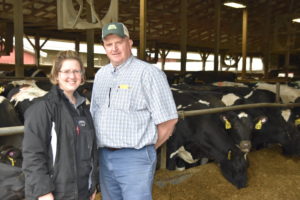
AJ and Jeanne Wormuth are operators of Half Full Dairy.
By Lynnette Wright, FSA
AJ and Jeanne Wormuth are operators of Half Full Dairy in Elbridge, New York. These farmers stay true to their name, always looking at the glass half full.
Joining the Business
AJ and Jeanne recently purchased the cows from Hourigan’s Dairy Farm in early 2019, the first step in buying the farm from the retiring farmers. While the couple recently started the process of buying the farm, they’ve been involved with the operation for years.
Discussions on making the transition began in 2014. In 2016, the Wormuths became farm managers, learning the ins and outs of the farm.
Now owners of 1,400 cows, AJ and Jeanne renamed the operation Half Full Dairy, renting the facilities and purchasing feed from the Hourigans until the transition is complete.
Expanding the Farm
In preparation for buying into the farm, the Wormuths planned to build a 15,000-gallon milk silo on the farm to expand their milking capacity.
With a Farm Storage Facility Loan from USDA’s Farm Service Agency, AJ and Jeannie installed the new milk silo and an upgraded milk cooling system in April. The program provides low-interest financing so producers can build or upgrade facilities to store commodities.
“The staff in my county FSA office were very helpful in the application process,” said AJ. “They were there every step of the way making sure we got through the process successfully.”

Having the extra storage has increased production and helped save the farm money.
Having the extra storage has increased production and helped save the farm money. With more milk storage capacity, the Wormuths consistently milk three times per day, with their milk being picked up by their milk cooperative daily.
Prior to adding the new milk silo, their milk had to be picked up twice a day due to using a smaller storage tank. The addition of the milk silo not only added much needed storage, but also saved the dairy money by reducing their milk pick up to once daily.
The new cooling system also has provided an economic benefit to Half Full Dairy by reducing energy costs. Fresh milk is warm and needs to be cooled to below 40 degrees quickly. The chiller system uses propylene glycol and a plate cooler, which works as a heat exchanger. The warm milk runs through the plate cooler and then even colder propylene glycol chambers. As the milk passes over these chambers, it cools quickly, ensuring its freshness and quality.
AJ and Jeanne believe that staying positive is essential to their success. Dairy farming is full of challenges, but with their glass-half-full mentality, the Wormuth family is hopeful for the future.
More Information
USDA offers a variety of risk management, disaster assistance, loan, and conservation programs to help agricultural producers in the United States weather ups and downs in the market and recover from natural disasters as well as invest in improvements to their operations. Learn about additional programs.
For more information about USDA programs and services, contact your local USDA service center.
JOIN THE CONVERSATION
For the digital version of this blog, visit #FridaysOnTheFarm.
Follow the #FridaysOnTheFarm story series and other news you can use on farmers.gov and our social media channels: Twitter, Instagram, YouTube, Flickr, and Facebook.





